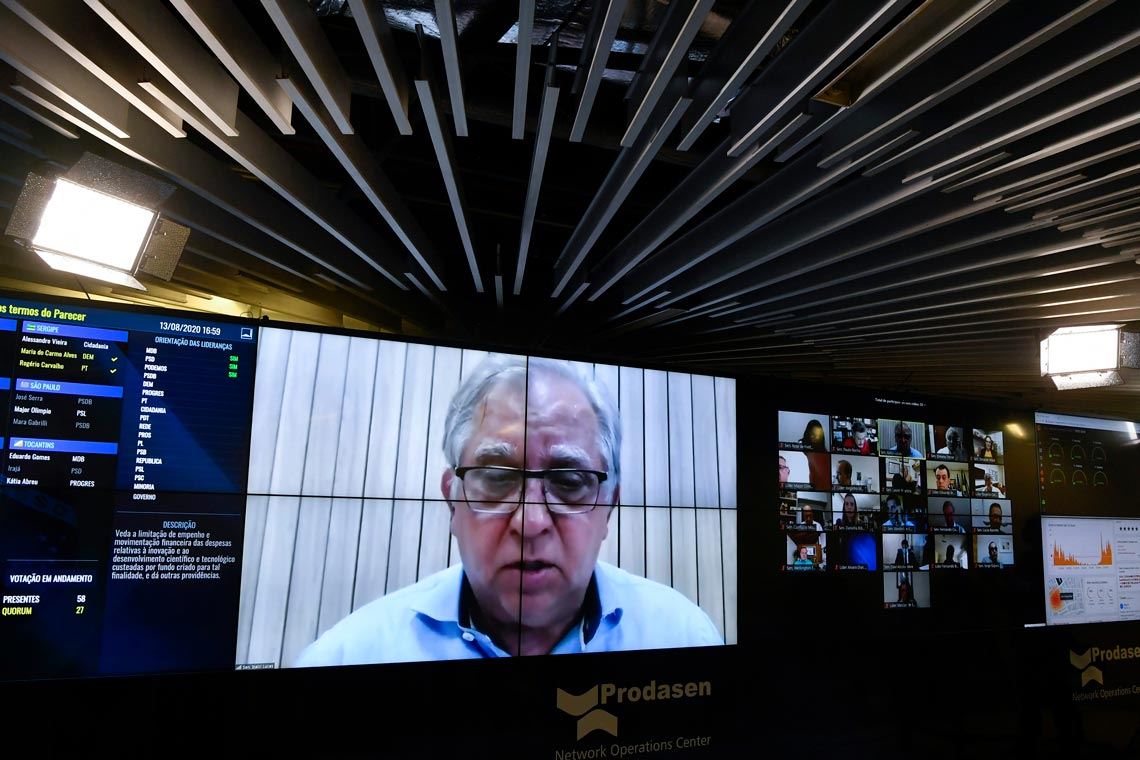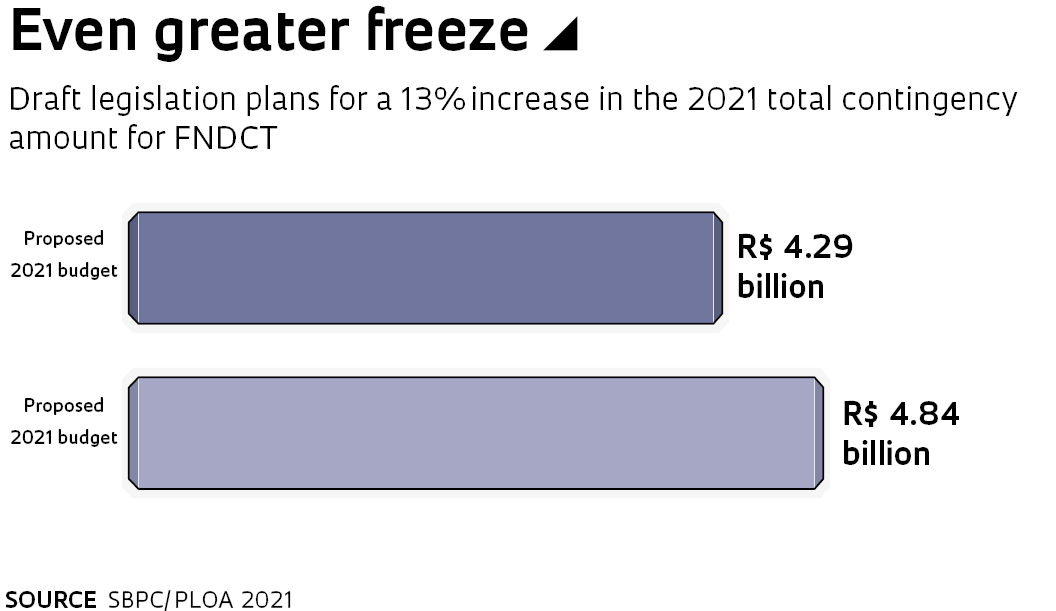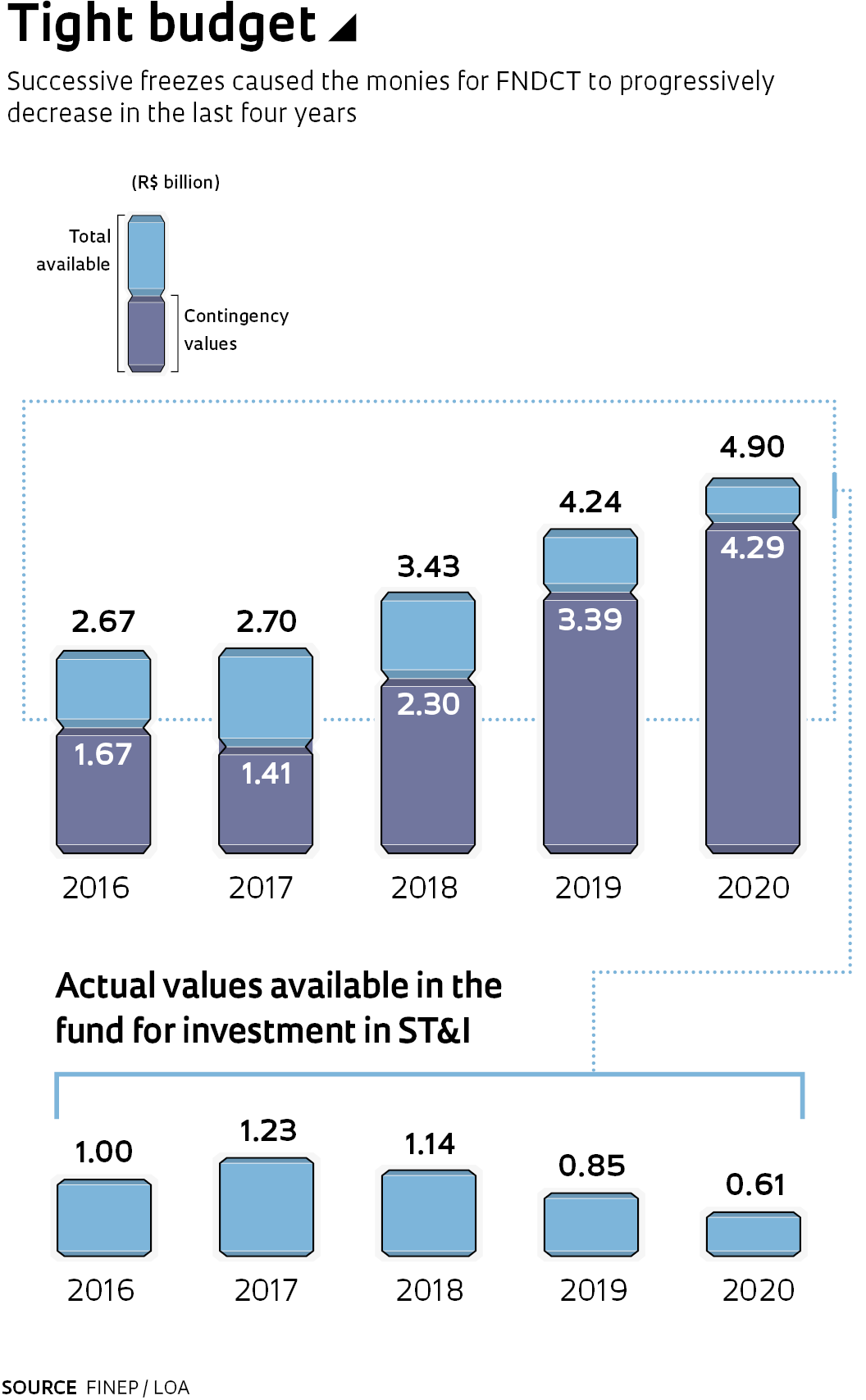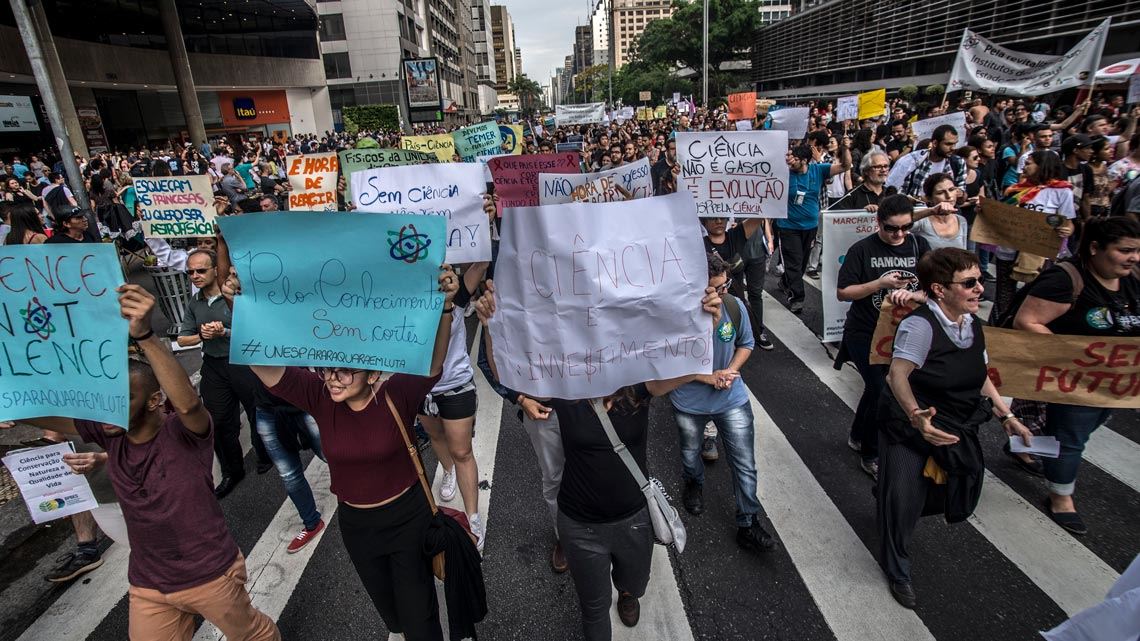In January, President Jair Bolsonaro (independent) vetoed Complementary Bill no. 135/20, which establishes changes to the Federal Scientific and Technological Development Fund (FNDCT), the key funding agency for science, technology, and innovation (ST&I) in Brazil. The bill, which was approved last year by a vast majority in the House and the Senate, transforms the FNDCT into a cumulative investment fund—today, the fund receives income from various economic sectors, but which is only for accounting purposes. With this change, its reserves could be moved to investment funds, generating a return that can be used to fund ST&I activities. Another new element relates to the reutilization of unused annual surpluses to be reinvested such that resources accumulate over time—today monies that are not spent are returned to the State.
The bill also prohibited new contingencies for fund resources—in the last five years, only a fraction of available funds could be used—and freed up R$4.2 billion in blocked monies in 2020. These two changes, however, were vetoed by the economic team. In this decision, published in the January 13 edition of the Diário Oficial da União (State official journal), argues that the way in which they (the changes) were approved in Congress, the measures “will contradict public interest” as they conflict with current legal provisions. According to this view, it would result in an unexpected increase in expenses and a significant impact on public finances, leading to non-compliance with Constitutional Amendment no. 95, which instituted a 20-year ceiling on public spending in 2016. It also means that, requiring the immediate execution of 2020 contingency resources would force the cancelation of funds from remaining files already programmed for this purpose, interfering with the implementation of projects and actions planned by other areas of government—this would result in budgetary inflexibility.
“The presidential vetoes damage the PLP 135/20, whose key objective was to prevent the blocking of FNDCT resources this year,” says senator Izalci Lucas (PSDB-DF), the primary author of the bill. In his opinion, the decision shows “a lack of strategic vision” by the federal government with regard to the role of ST&I in the country’s social and economic development. “The vetoes contradict the spirit of the bill, placing Brazil against the rest of the world which, during the pandemic, increased support of ST&I (see Pesquisa FAPESP issue no. 294)”, adds Fernando Peregrino, president of the National Council of Foundations for the Support of Higher Education Institutions and Scientific and Technological Research (CONFIES).

Leopoldo Silva / Senate Agency
Senator Izalci Lucas during remote plenary session of the Senate to vote on PLP 135/20 in August 2020Leopoldo Silva / Senate AgencyThe order of vetoes to the PLP 135/20, now Complementary Bill no. 177, did not surprise engineer Pedro Wongtschowski, president of the Board of Directors of Ultrapar Shareholdings and head of Business Mobilization for Innovation (MEI) for the National Confederation of Industry (CNI), which has promoted conversation between government and industry sectors. “We knew that the greatest opposition would come from the economic team, which expects to use sectoral fund revenues that sustain the FNDCT to adjust government accounts,” clarifies Wongtschowski, member of FAPESP’s Board of Trustees. On the other hand, Gianna Sagazio, director of innovation at CNI and coordinator at MEI, argues that the vetoed measures would not impact government accounts. “The budgetary appropriation planned by the Ministry of Science, Technology, and Innovations (MCTI) in the proposed budgetary bill already includes the total amount collected by the FNDCT, such that the investment made with the fund’s resources does not factor into the expenses that comprise the primary deficit,” she explains. “There is also no risk of surpassing the expenditure ceiling, given the proposal defended by PLP 135/20 does not assume a budgetary increase for the MCTI.”
The scientific community expects Congress to overturn the vetoes. “We approved the bill with a clear majority in the House and in the Senate, which suggests that the probability of the vetoes being overturned is high. In any case, we have to wait for parliament to return from recess to restart the debate,” notes senator Lucas. According to Celso Pansera, ex-delegate and ex-minister of Science, Technology, and Innovations, the problem is that this could take time. “There is the election of presidents of the two legislative assemblies in February and many other agenda items to vote on, such that the analysis of the vetoes could be moved to March, April, or May, after the beginning of the next fiscal year,” he says. The bill, in this case, will be considered in light of changes made by the government and, even with the overturned vetoes, the measures will only take effect in 2022. As such, ST&I perspectives in 2021 are under criticism and could worsen if the 2021 Annual Budgetary Bill (PLOA 2021) presented by the Executive is approved. The bill plans for a 13% increase in the 2021 total contingency amount for FNDCT in relation to the previous year, which represents slightly more than R$4.8 billion (see graphic below).

Despite the vetoes, the bill guarantees some victories, such as the transformation of the FNDCT into a cumulative investment fund and the possibility of taking advantage of unused annual surpluses for reinvestment. “If this had been done 10 years ago, even with all of the contingencies throughout this period, the FNDCT would have an accumulated surplus of close to R$45 billion,” confirms economist and federal ex-representative Marcos Cintra, professor at the São Paulo School of Business Administration at the Getulio Vargas Foundation (FGV/EAESP). Cintra created the proposal for transforming the FNDCT into an investment fund and reinvesting unused annual surpluses, when he was head of the Brazilian Funding Authority for Studies and Projects (FINEP), an agency linked to the MCTI and responsible for administering the fund between 2016 and 2018. In his opinion, these changes should help transform the FNDCT into a source of sustainable investment. “The reutilization of unused accumulated surpluses should assure the predictability of government resources for strategic projects, allowing FINEP to improve the planning for its funding activities,” he says. “This is important because investments in ST&I are long term and therefore require stability.” However, adds Izalci Lucas, for these changes to make sense, Congress must overturn the vetoes. “There is no point in having an investment fund and not have the money to invest,” he notes. “If governors do not understand that we are only going to get out of these crises by investing in education, science, and technology, we will not go anywhere.”
There is significant agreement in this regard in National Congress. The approval of PLP 135/20 in the Senate, in August, was almost by acclamation. There were 71 votes in favor and only one against, by senator Flávio Bolsonaro (Republicans-RJ). In the House of Representatives, in December, it was the same: 385 voted in favor of the bill, while 18 were against, among them all of the delegates of the New party and some congressmen of the PSL. In Lucas’ opinion, the near unanimity in relation to the future of the FNDCT means there is an alignment among congressmen and senators of different parties around the importance and strategic potential of ST&I for Brazil. For Cintra, this shows “that worthy projects, such as this, have a magic wand that brings together parliamentarians from various policitical and ideological orientations.”
Despite the vetoes, new bill guarantees the transformation of FNDCT into an investment fund with the possibility of reutilization of accumulated surpluses
Building this consensus was made possible by extensive political discussion, developed in the context of the Mixed Parliamentary Front for Science, Technology, Research, and Innovation, chaired by Lucas for the past two years. The front has 207 parliamentarians from various parties, who meet in sessions with members from the scientific community and civil society to discuss topics of interest to the sector. In November 2019 in Brazil, in partnership with MEI, the front promoted a meeting that included various authorities including Rodrigo Maia (DEM-RJ) and Davi Alcolumbre (DEM-AP), presidents of the House of Representatives and the Senate, respectively, as well as business professionals from various sectors of the industry. The idea was to discuss innovation as a trajectory for the development and significance of a long-term proprietary policy, based on goals and guarantee of resources. At the same time, on the initiative of the scientific community, the Brazilian Society for the Advancement of Science (SBPC) launched in May of that year the Science and Technology Parliament Initiative (ICTP.br), in partnership with the Brazilian Academy of Science (ABC) and other organizations. The goal was to promote more integrated conversation with parliamentarians to be able to present them with the needs of the sector.
This conversation among scientific organizations, representatives from different industry sectors, and parliamentarians helped to stall budget reductions for ST&I in 2020 (see Pesquisa FAPESP issue no. 289). More recently, it also prevented the actual termination of the FNDCT. In March 2020, the Constitution and Justice Commission of the Senate removed the fund from the scope of Constitutional Amendment Proposal (PEC) no. 187 of 2019, which proposed to terminate public funding linked to specific areas and direct these resources to other purposes in an effort to stimulate the economy (see Pesquisa FAPESP issue no. 290). In addition to FNDCT, they saved the Public Safety Fund, Antidrug Fund, and Fund for the Defense of the Coffee Economy (FUNCAFÉ). However, the situation remained undecided regarding the Sectoral Funds for Science and Technology, the primary source of funding for FNDCT. The PEC no. 187 is expected to be voted on this year. The expectation is that the proclamation of PLP 135/20 will bring with it sectoral funding, excluding them from the scope of the proposal. “It would not make sense to have the FNDCT without the funds to sustain it,” says Pansera.
According to Moreira, president of SBPC, the freeze on funding for FNDCT compromises the fight against Covid-19 and stalls Brazil’s economic recovery
The current structure for raising funds for the FNDCT is the result of a lengthy project carried out between 1998 and 2001, leading to the creation of sectoral funding. “They allowed for the mobilization of resources from various sources, based on bills approved by National Congress with near unanimity,” says economist and engineer Carlos Américo Pacheco, executive director of the Technical-Administrative Council of FAPESP. “There was always an expectation to create a stable source of funding for scientific and technological development and innovation in Brazil. The approval of PLP 135/20 would put the icing on the cake,” adds Pacheco, one of the creators of the funds at the time when he was executive secretary for then Minister of Science and Technology, between 1999 and 2002.
The contingency funding is the primary bottleneck of the FNDCT (see Pesquisa FAPESP issue no. 285). In an effort to curb a decline in government accounts, successive budgetary freezes decreed by government caused progressive reductions in the money available in the fund in recent years, threatening its capacity to fund scholarships and research projects in universities and companies (see graphic). In 2020, the continency for FNDCT reached the highest level over the past five years. Of its R$4.9 billion budget, R$4.2 billion (87.5%) was transferred to a reserve fund, which was available to the government to pay down public debt and fiscal surpluses. “It is blatantly illegal,” points out physicist Ildeu de Castro Moreira, president of SBPC. “There is no justification to use these resources for another purpose other than for the improvement of ST&I infrastructure for Brazil’s research institutions and funding for technological innovation among companies.” According to Moreira, blocking resources for ST&I not only compromises the fight against Covid-19, but also obstructs Brazil’s economic recovery, placing the country “in a situation of significant delay, growing inequalities, and overall impoverishment.”

Disputes between the scientific field and the government’s economic team regarding FNDCT resources are long-standing, but they began to intensify in 2015 with the accelerated growth of expenditures and public debt in Brazil. Between January and October 2020, federal government accounts accumulated a deficit of approximately R$681 billion—in 2021, this amount could reach more than 90% of Brazil’s gross domestic product (GDP). “The economic department will always want space to reduce government expenditures. This is normal,” points out Wongtschowski. “The problem is that, on the other side, the MCTI in recent years lost its political strength and influence to garner support for its interests. The scale was very skewed.” Meanwhile, many countries are strengthening their ST&I policies, investing more than 2% of GDP in the sector. In Brazil, this number is still below this. “This is one of the reasons for relative stagnation in ST&I in the country in recent years. Thus, it is important that Congress revisit the vetoes and overturn them as soon as possible,” concludes Cintra.
Republish